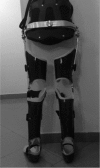Influence of Reciprocating Link When Using an Isocentric Reciprocating Gait Orthosis (IRGO) on Walking in Patients with Spinal Cord Injury: A Pilot Study
- PMID: 29339901
- PMCID: PMC5562033
- DOI: 10.1310/sci16-00016
Influence of Reciprocating Link When Using an Isocentric Reciprocating Gait Orthosis (IRGO) on Walking in Patients with Spinal Cord Injury: A Pilot Study
Abstract
Background: Studies collectively imply that the reciprocal link has no effect on walking when using reciprocating gait orthoses (RGOs). There may be differences between the 2 configurations of the RGO (eg, isocentric reciprocating gait orthosis [IRGO] and IRGO without reciprocating link), but the specific benefits and problems encountered in their use must be understood. Purpose: To highlight more evidence for the mechanical function of the reciprocal link in RGOs used for walking by individuals with spinal cord injury (SCI). Methods: Nine people with SCI participated in this study. Gait analysis was performed in 2 conditions (walking with IRGO and walking with IRGO without reciprocating link) in a random order. The Vicon digital capture system was used to obtain kinematic data. Results: There were significant differences between each orthotic configuration in terms of speed of walking (p = .029), step length (p = .048), hip joint range of motion (ROM) (p ≤ .001), and lateral and vertical compensatory motions (p ≤ .001). There was no significant difference between each orthotic configuration in cadence (p = .162). Conclusion: The reciprocating link in IRGO improved the walking parameters in SCI patients.
Keywords: isocentric reciprocating gait orthosis; orthotic gait training; reciprocal link; spinal cord injury; walking.
Figures
References
-
- Walter J, Sola P, Sacks J, Lucero Y, Langbein E, Weaver F.. Indications for a home standing program for individuals with spinal cord injury. J Spinal Cord Med. 1998; 22 3: 152– 158. - PubMed
-
- Eng JJ, Levins SM, Townson AF, Mah-Jones D, Bremner J, Huston G.. Use of prolonged standing for individuals with spinal cord injuries. Phys Ther. 2001; 81 8: 1392– 1399. - PubMed
-
- Ahmadi Bani M, Arazpour M, Farahmand F, Mousavi ME, Hutchins SW.. The efficiency of mechanical orthoses in affecting parameters associated with daily living in spinal cord injury patients: A literature review. Disabil Rehabil Assist Technol. 2014: 1– 8. - PubMed
-
- Arazpour M, Bani MA, Hutchins SW.. Reciprocal gait orthoses and powered gait orthoses for walking by spinal cord injury patients. Prosthet Orthot Int. 2013; 37 1: 14– 21. - PubMed
MeSH terms
LinkOut - more resources
Full Text Sources
Other Literature Sources
Medical


